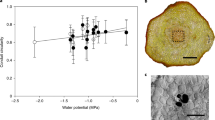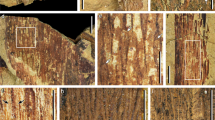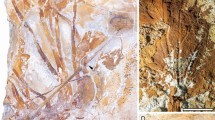Abstract
Tyloses are swellings of parenchyma cells into adjacent water-conducting cells that develop in vascular plants as part of heartwood formation or specifically in response to embolism and pathogen infection. Here we document tyloses in Late Devonian (approximately 360 Myr ago) Callixylon wood. This discovery suggests that some of the earliest woody trees were already capable of protecting their vascular system by occluding individual conducting cells.
This is a preview of subscription content, access via your institution
Access options
Access Nature and 54 other Nature Portfolio journals
Get Nature+, our best-value online-access subscription
$29.99 / 30 days
cancel any time
Subscribe to this journal
Receive 12 digital issues and online access to articles
$119.00 per year
only $9.92 per issue
Buy this article
- Purchase on Springer Link
- Instant access to full article PDF
Prices may be subject to local taxes which are calculated during checkout

Similar content being viewed by others
Data availability
All data that support the findings of this study are included in this published article and its Supplementary Information files. A high-resolution image of the section showing tylosis from Supplementary Fig. 3 is also available on Figshare at https://doi.org/10.6084/m9.figshare.21572448.v1. The fossil and associated slides are currently on loan at UMR AMP Montpellier and accessible under specimen number HH5 (for HookHead No. 5). This material and other fossils illustrated in the supplementary figures will ultimately be deposited in the Trinity Geological Museum, Trinity College Dublin, Dublin, Ireland, once the study of the assemblage is completed.
References
Esau, K. Plant Anatomy (Wiley & Sons, 1965).
De Micco, V., Balzano, A., Wheeler, E. A. & Baas, P. Tyloses and gums: a review of structure, function and occurrence of vessel occlusions. IAWA J. 37, 186–205 (2016).
Sun, Q., Rost, T. L., Reid, M. S. & Matthews, M. A. Ethylene and not embolism is required for wound-induced tylose development in stems of grapevines. Plant Physiol. 145, 1629–1636 (2007).
Leśniewska, J. et al. Defense responses in aspen with altered pectin methylesterase activity reveal the hormonal inducers of tyloses. Plant Physiol. 173, 1409–1419 (2017).
Shigo, A. L. Compartmentalization: a conceptual framework for understanding how trees grow and defend themselves. Annu. Rev. Phytopathol. 22, 189–214 (1984).
Decombeix, A.-L., Harper, C. J., Galtier, J., Meyer-Berthaud, B. & Krings, M. Tyloses in fossil plants: new data from a Mississippian tree, with a review of previous records. Bot. Lett. 169, 510–526 (2022).
Edwards, D. Xylem in early tracheophytes. Plant Cell Environ. 26, 57–72 (2003).
Gerrienne, P. et al. A simple type of wood in two Early Devonian plants. Nature 333, 837–837 (2011).
Hoffman, L. A. & Tomescu, A. M. F. An early origin of secondary growth: Franhueberia gerriennei gen. et sp. nov. from the Lower Devonian of Gaspé (Quebec, Canada). Am. J. Bot. 100, 754–763 (2013).
Pfeiler, K. C. & Tomescu, A. M. F. An Early Devonian actinostelic euphyllophyte with secondary growth from the Emsian of Gaspé (Canada) and the importance of tracheid wall thickening patterns in early euphyllophyte systematics. Pap. Palaeontol. 7, 1081–1095 (2021).
Decombeix, A.-L., Boura, A. & Tomescu, A. M. F. Plant hydraulic architecture through time: lessons and questions on the evolution of vascular systems. IAWA J. 40, 387–420 (2019).
Harrison, C. J. & Morris, J. L. The origin and early evolution of vascular plant shoots and leaves. Phil. Trans. R. Soc. B 373, 20160496 (2018).
Stein, W. E. et al. Mid-Devonian Archaeopteris roots signal revolutionary change in earliest fossil forests. Curr. Biol. 30, 421–431.e2 (2020).
Stubblefield, S. P., Taylor, T. N. & Beck, C. B. Studies of Paleozoic fungi. IV. Wood-decaying fungi in Callixylon newberryi from the Upper Devonian. Am. J. Bot. https://doi.org/10.2307/2443734 (1985).
Taylor, T. N., Krings, M. & Taylor, E. L. Fossil Fungi (Academic Press, 2015); https://doi.org/10.1016/C2010-0-68335-0
Beck, C. B. Connection between Archaeopteris and Callixylon. Science 131, 1524–1525 (1960).
Meyer-Berthaud, B., Scheckler, S. E. & Wendt, J. Archaeopteris is the earliest known modern tree. Nature 398, 700–704 (1999).
Cascales-Miñana, B., Gerrienne, P., Sirjacq, B. & Steemans, P. On the hydraulic conductance of three woody Devonian plants. IAWA J. 40, 446–465 (2019).
Tanrattana, M., Barczi, J.-F., Decombeix, A.-L., Meyer-Berthaud, B. & Wilson, J. P. A new approach for modelling water transport in fossil plants. IAWA J. 40, 466–487 (2019).
Anderson, H. M., Hiller, N. & Gess, R. W. Archaeopteris (Progymnospermopsida) from the Devonian of southern Africa. Bot. J. Linn. Soc. https://doi.org/10.1111/j.1095-8339.1995.tb02593.x (1995).
Klavins, S. D. Systematics and Paleoecology of Three Late Devonian Floras of Southern Ireland. PhD thesis, Southern Illinois Univ. at Carbondale (1999); https://www.proquest.com/openview/d91f8c298225c62ef712a196593fc52e
Boucot, A. J., Xu, C., Scotese, C. R. & Morley, R. J. Phanerozoic Paleoclimate: An Atlas of Lithologic Indicators of Climate (SEPM Society for Sedimentary Geology, 2013); https://doi.org/10.2110/sepmcsp.11
Bouda, M. et al. Hydraulic failure as a primary driver of xylem network evolution in early vascular plants. Science 378, 642–646 (2022).
Sleeman, A. G., Higgs, K. T. & Sevastopulo, G. D. Stratigraphy of the late Devonian- early Carboniferous rocks of south Co. Wexford. Bull. Geol. Surv. Ireland 3, 141–158 (1983).
Matten, L. C. A petrified lycopod from the uppermost Devonian of Hook Head, County Wexford, Ireland. Bot. Gaz. 150, 323–336 (1989).
Klavins, S. D. Re-interpretation of Wexfordia hookense from the Upper Devonian of Ireland as an arborescent lycophyte. Bot. J. Linn. Soc. 144, 275–287 (2004).
Stein, W. E., Wight, D. C. & Beck, C. B. Techniques for preparation of pyrite and limonite permineralizations. Rev. Palaeobot. Palynol. 36, 185–194 (1982).
Orlova, O. A. & Jurina, A. L. Genus Callixylon Zalessky (Archaeopteridophyta): main criteria for distinguishing its species and revision of its species composition. Paleontol. J. 45, 580–589 (2011).
Acknowledgements
This work was supported by a Tellus-Interrvie grant (DECA, CNRS-Institut National des Sciences de l’Univers) to A.-L.D. and a PHC Ulysses grant (no. 47212TK, Irish Research Council and French Ministry of Foreign Affairs) to C.J.H. and A.-L.D. We thank C. Girard (ISEM Montpellier) and B. Meyer-Berthaud (AMAP, Montpellier) for help in the field and comments on a previous draft of the paper. AMAP (botAny and Modelling of Plant Architecture and vegetation) is a joint research unit involving Montpellier University, CNRS (UMR 5120), CIRAD (UMR51), INRAe (UMR931) and IRD (UR123).
Author information
Authors and Affiliations
Contributions
A.-L.D. and C.J.H. initiated the research project. A.-L.D., C.P. and T.D. participated in the fieldwork during which the material was collected. M.R. prepared the sections. A.-L.D. and M.R. photographed the sections. A.-L.D., C.J.H. and M.K. analysed the data with input from T.D. and C.P. C.P. analysed the sedimentological context and prepared the spores and cuticles illustrated in the supplementary figures. A.-L.D. and M.K. prepared the paper with contributions from all co-authors.
Corresponding author
Ethics declarations
Competing interests
The authors declare no competing interests.
Peer review
Peer review information
Nature Plants thanks Alexandru Tomescu, Zhuo Feng and the other, anonymous, reviewer(s) for their contribution to the peer review of this work.
Additional information
Publisher’s note Springer Nature remains neutral with regard to jurisdictional claims in published maps and institutional affiliations.
Supplementary information
Supplementary Information
Supplementary Figs. 1–3.
Rights and permissions
Springer Nature or its licensor (e.g. a society or other partner) holds exclusive rights to this article under a publishing agreement with the author(s) or other rightsholder(s); author self-archiving of the accepted manuscript version of this article is solely governed by the terms of such publishing agreement and applicable law.
About this article
Cite this article
Decombeix, AL., Harper, C.J., Prestianni, C. et al. Fossil evidence of tylosis formation in Late Devonian plants. Nat. Plants 9, 695–698 (2023). https://doi.org/10.1038/s41477-023-01394-0
Received:
Accepted:
Published:
Issue Date:
DOI: https://doi.org/10.1038/s41477-023-01394-0



